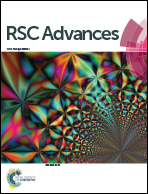Visible light driven photocatalytic oxidation of thiols to disulfides using iron phthalocyanine immobilized on graphene oxide as a catalyst under alkali free conditions
Abstract
The present paper describes the synthesis of graphene oxide immobilized iron phthalocyanine (FePc) for the photocatalytic oxidation of thiols to disulfides under alkaline free conditions. Iron phthalocyanine tetrasulfonamide was immobilized on carboxylated graphene oxide supports via covalent attachment. The loading of FePc on GO nanosheets was confirmed by FTIR, Raman, ICP-AES, UV-Vis and elemental analyses. The synthesized catalyst was found to be highly efficient for the photo-oxidation of thiols to disulfides in aqueous medium using molecular oxygen as oxidant under visible light irradiation. The identification of photo-oxidation products and their quantitative determination was done using GC-MS. After completion of the reaction, the catalyst was easily recovered by filtration and reused for several runs without loss in activity and no leaching was observed during the reaction.


 Please wait while we load your content...
Please wait while we load your content...